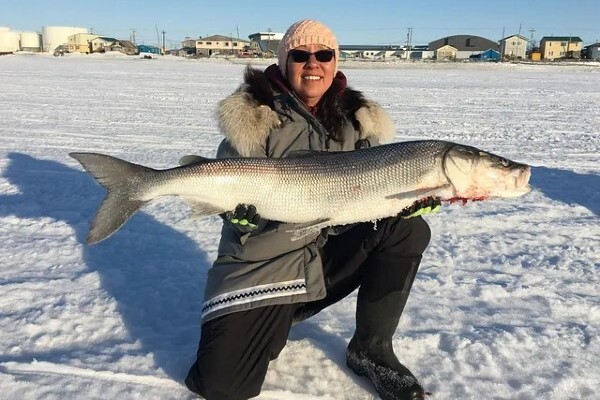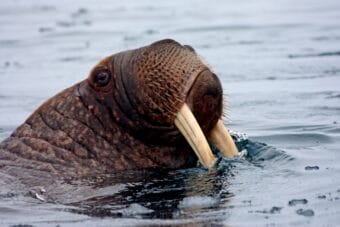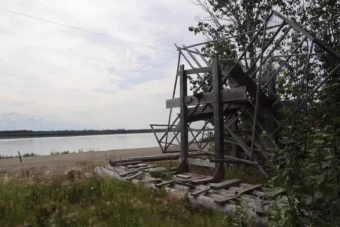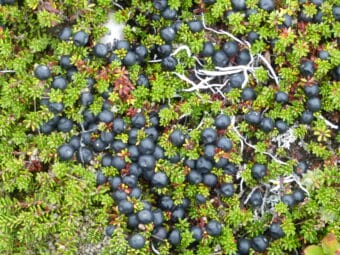
Lance Kramer describes himself as an avid outdoorsman. The 52-year old loves traditional methods of hunting, fishing and trapping. His home is right next to the ice where many Kotzebue residents fish for sheefish. It gives him a bird’s-eye view to gauge when the fish are coming in.
“I get to watch every day, you know, out my window,” Kramer said. “My barometer is binoculars. If they’re pulling them up, then it’s time to go. If they’re not, stay in and drink coffee.”
Kramer is among many people living in Alaska’s Northwest Arctic who depend on sheefish as a staple in their diets. The fish, right now, are abundant. Residents’ freezers are filled with them after another successful season. But scientists warn that it may not always be this way. They say warming waters and permafrost thaw could lead to population declines. It’d be a double-whammy for a region already dealing with recent population declines in another key food source: caribou.
“When you don’t have any caribou in your freezer all year long, you know, sheefish is a huge reprieve,” said Kramer.
‘Sheefishing is a science’
Sheefish, or simply sii, are a whitefish found only in certain waterways in the Northern Hemisphere. In Alaska, they’re found in the Yukon and Kuskokwim drainage areas. In the Northwest Arctic, their spawning grounds are along the upper Kobuk and Selawik rivers. Here, individual sheefish are significantly larger than their counterparts elsewhere in the state. A single fish can measure 3.5 feet and weigh 60 pounds.
One fish is enough to provide several meals to a large family. They’re valued for their taste. The flakey white meat is oily and slightly sweet which makes it versatile in many dishes.
“There’s so many ways to eat them,” Kramer said. “It’s like Forrest Gump. Remember how he talked about the shrimp?”
Kramer, like many people in the region, fishes using a combination of traditional methods with modern equipment. He travels by snowmachine to the ice and, using an auger, drills a 10-inch hole. He looks for a “wedge” in the brackish water, where the fresh and salt waters meet. During winter, the sheefish tend to stay in the relatively warmer freshwater, occasionally venturing into the colder marine water to hunt for their next meal.
“Sheefishing is a science,” he said.
To catch the fish, Kramer uses a jig — a bent handle about a foot long with a line and hook attached. Sheefishing is typically done with a jig or net, not the rod and reel commonly used by many sports fishermen. Kramer uses the Iñupiaq words for his jig. His aulasuan, or handle, is made from wood or walrus ivory. For the ipiataq or fishing line, he uses a more heavy-duty 80-pound test line which attaches to the niksik, or hook. Kramer said he’s addicted to what he calls “the tug” — that initial feeling of hooking a sheefish on the line.
“It’s a direct connection between the energy of that huge incredible sheefish and your hand,” he said. “It’s the energy.”
A threat from thawing permafrost
Although sheefish are abundant now, they could be threatened by warming Arctic temperatures, according to Bill Carter, a fish biologist for the Selawik National Wildlife Refuge, based in Kotzebue. His focus is on the refuge’s aquatic habitat. For eight years, he and a group of Fish and Wildlife colleagues studied a potential threat to sheefish: the permafrost thaw slump.
“It’s basically a big mudslide where a south-facing slope has started to thaw into water, turning what used to be firm ground into mud and concrete — basically wet concrete,” Carter said.
Following a slump, the water becomes cloudy and full of sediment potentially suffocating the eggs of spawning sheefish. Sheefish are long-lived fish. It takes 10 years for the sheefish in the Northwest Arctic to reach sexual maturity which means that the threats to spawning could have longer lasting repercussions.
According to Carter, there have been several slumps in the region. One of the most concerning on Selawik River — about 10 miles upriver from sheefish spawning grounds — was massive.
“[It was] over 500,000 cubic meters, which is basically a 25-story building with a footprint the size of a football field,” said Carter. “That’s what’s come out of it. So it’s really big, over a half a mile across.”
He said there are several more permafrost thaw slumps in the region.
Kramer said he has the same concerns as Carter. He believes that along with warming waters and harmful algal blooms, the permafrost thaw slump will pose a threat to sheefish in the future. Carter and a group of scientists are planning a two-year project this summer to study how the thaw slump has affected sheefish populations.



